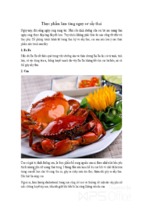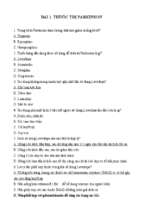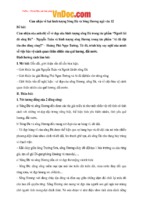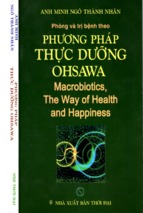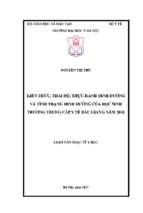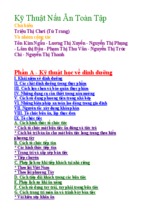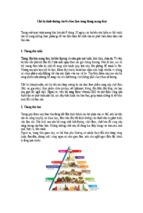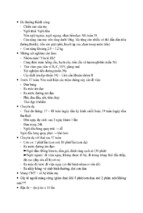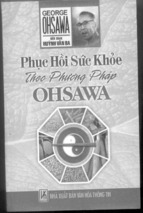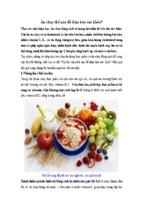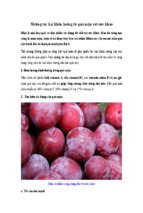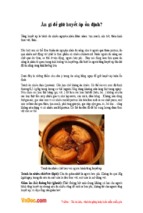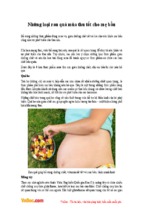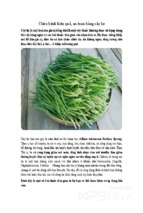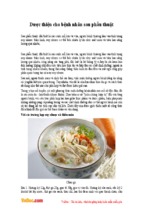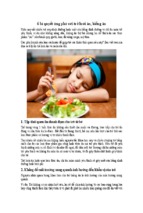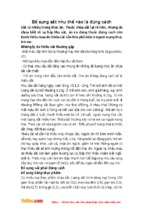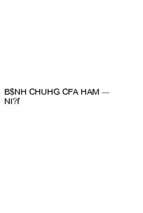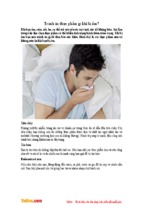GUIDELINE
DAILY IRON
SUPPLEMENTATION
in adult women and
adolescent girls
2016
Guideline:
DAILY IRON SUPPLEMENTATION
IN ADULT WOMEN
AND ADOLESCENT GIRLS
WHO Library Cataloguing-in-Publication Data
Guideline: Daily iron supplementation in adult women and adolescent girls
1. Iron - administration and dosage. 2. Anemia, Iron-deficiency - prevention and control. 3. Menstruation
- complications. 4. Women. 5. Adolescent. 6. Dietary Supplements. 7. Guideline. I. World Health Organization.
ISBN 978 92 4 151019 6
(NLM classification: WH 160)
© World Health Organization 2016
All rights reserved. Publications of the World Health Organization are available on the WHO website (www.
who.int) or can be purchased from WHO Press, World Health Organization, 20 Avenue Appia, 1211 Geneva 27,
Switzerland (tel.: +41 22 791 3264; fax: +41 22 791 4857; e-mail:
[email protected]).
Requests for permission to reproduce or translate WHO publications –whether for sale or for non-commercial
distribution– should be addressed to WHO Press through the WHO website (www.who.int/about/licensing/
copyright_form/en/index.html).
The designations employed and the presentation of the material in this publication do not imply the
expression of any opinion whatsoever on the part of the World Health Organization concerning the legal
status of any country, territory, city or area or of its authorities, or concerning the delimitation of its frontiers
or boundaries. Dotted and dashed lines on maps represent approximate border lines for which there may not
yet be full agreement.
The mention of specific companies or of certain manufacturers’ products does not imply that they are
endorsed or recommended by the World Health Organization in preference to others of a similar nature that
are not mentioned. Errors and omissions excepted, the names of proprietary products are distinguished by
initial capital letters.
All reasonable precautions have been taken by the World Health Organization to verify the information
contained in this publication. However, the published material is being distributed without warranty of any
kind, either expressed or implied. The responsibility for the interpretation and use of the material lies with the
reader. In no event shall the World Health Organization be liable for damages arising from its use.
Cover design and layout: Chris Yuen
Document layout: Elysium sàrl
Printed by the WHO Document Production Services, Geneva, Switzerland
SUGGESTED CITATION
Guideline: Daily iron supplementation in adult women and adolescent girls. Geneva: World Health Organization;
2016.
iv
WHO Guideline: Daily iron supplementation in adult women and adolescent girls
CONTENTS
ACKNOWLEDGEMENTS VI
Financial support VI
EXECUTIVE SUMMARY 1
Purpose of the guideline 1
Guideline development methodology 1
Available evidence 1
Recommendation 2
Remarks 2
Research priorities 3
SCOPE AND PURPOSE 4
BACKGROUND 4
OBJECTIVES 5
SUMMARY OF AVAILABLE EVIDENCE 5
RECOMMENDATION 6
RATIONALE 6
REMARKS 7
RESEARCH PRIORITIES 8
DISSEMINATION, IMPLEMENTATION AND ETHICAL CONSIDERATIONS 8
Dissemination 8
Implementation 9
Regulatory considerations 9
Monitoring and evaluation of guideline uptake and adaptation
9
GUIDELINE DEVELOPMENT PROCESS 10
Advisory groups 10
Scope of the guideline, evidence appraisal and decision-making
11
MANAGEMENT OF COMPETING INTERESTS 12
PLANS FOR UPDATING THE GUIDELINE 13
REFERENCES 14
ANNEX 1.
GRADE summary of findings table 16
ANNEX 2.
Summary of the considerations of the members of the guideline development group
for determining the strength of the recommendation for daily oral iron supplementation
in menstruating adult women and adolescent girls
17
ANNEX 3.
WHO Steering Committee for Nutrition Guidelines Development
18
ANNEX 4.
WHO guideline development group 19
ANNEX 5. External resource experts 22
ANNEX 6. WHO SECRETARIAT 23
ANNEX 7. PEER-REVIEWERS 24
ANNEX 8.
Questions in population, intervention, control, outcomes (PICO) format
25
Effects and safety of iron supplementation in menstruating adult women and adolescent girls
25
WHO Guideline: Daily iron supplementation in adult women and adolescent girls
v
ACKNOWLEDGEMENTS
This guideline was coordinated by the World Health Organization (WHO) Evidence and Programme Guidance
Unit, Department of Nutrition for Health and Development. Dr Pura Rayco-Solon, Dr Lisa Rogers and Dr Juan
Pablo Peña-Rosas oversaw the preparation of this document. WHO acknowledges the technical contributions
of the following individuals (in alphabetical order): Dr Andrea Bosman, Ms Hala Boukerdenna, Dr Carmen
Casanovas, Dr Camila Chaparro, Dr Maria Nieves García-Casal, Dr Viviana Mangiaterra, Ms Zita Weise Prinzo
and Mr Gerardo Zamora. We also thank the peer-reviewers Ms Solange Durao, Dr Tran Khanh Van and Ms
Terrie Wefwafwa.
We would like to express our gratitude to Dr Susan Norris from the WHO Guidelines Review Committee
Secretariat and members of the Guidelines Review Committee for their technical support throughout the
process. Thanks are also due to Ms Alma Alic from the Department of Compliance and Risk Management and
Ethics, for her support in the management of the conflicts of interests procedures. Ms Jennifer Volonnino,
from the Evidence and Programme Guidance Unit, Department of Nutrition for Health and Development,
provided logistic support.
WHO gratefully acknowledges the technical input of the members of the WHO Steering Committee for
Nutrition Guidelines Development and the WHO guidelines development groups, especially the chairs of the
meeting concerning this guideline, Ms Deena Alaasor and Dr Maria Elena del Socorro Jefferds.
Financial support
WHO thanks the Bill & Melinda Gates Foundation for providing financial support for this work. The
Micronutrient Initiative and the International Micronutrient Malnutrition Prevention and Control Program of
the United States Centers for Disease Control and Prevention (CDC) provided financial support to the Evidence
and Programme Guidance Unit, Department of Nutrition for Health and Development, for the commissioning
of systematic reviews of nutrition interventions. Donors do not fund specific guidelines and do not participate
in any decision related to the guideline development process, including the composition of research questions,
membership of the guideline groups, conduct and interpretation of systematic reviews, or formulation of
recommendations.
vi
WHO Guideline: Daily iron supplementation in adult women and adolescent girls
WHO GUIDELINE1: DAILY IRON SUPPLEMENTATION IN ADULT WOMEN AND ADOLESCENT GIRLS
EXECUTIVE SUMMARY
Globally, one in three non-pregnant women, corresponding to almost 500 million women, were anaemic in
2011. Iron deficiency is thought to contribute to at least half of the global burden of anaemia. Iron deficiency
occurs following prolonged negative iron balance, the major causes of which include inadequate intake
(owing to insufficient bioavailable iron in the diet or decreased iron absorption), increased iron requirements
(for instance, during periods of growth) and chronic blood loss (from heavy hookworm infection or menstrual
bleeding). In adolescent girls, menstrual blood losses, accompanied by rapid growth with expansion of the
red cell mass and increased tissue iron requirements, make them particularly vulnerable to iron deficiency
compared to male counterparts. This guideline reviews the evidence and updates the recommendation for
daily iron supplementation in menstruating adult women and adolescent girls.
Purpose of the guideline
This guideline aims to help Member States and their partners in their efforts to make informed decisions on
the appropriate nutrition actions to achieve the Sustainable Development Goals (SDGs) (1), the global targets
set in the Comprehensive implementation plan on maternal, infant and young child nutrition (2) and the
Global strategy for women’s, children’s and adolescent’s health (2016–2030) (3). The recommendation in this
guideline is intended for a wide audience, including policy-makers, their expert advisers, and technical and
programme staff at organizations involved in the design, implementation and scaling-up of programmes for
anaemia prevention and control, and in nutrition actions for public health. The recommendation supersedes
those of previous WHO guidelines on iron supplementation in adolescent girls and adult women where they
pertain specifically to daily oral iron supplementation among menstruating adult women and adolescent girls.
Guideline development methodology
WHO developed the present evidence-informed recommendation using the procedures outlined in the WHO
handbook for guideline development (4). The steps in this process included: (i) identification of priority questions
and outcomes; (ii) retrieval of the evidence; (iii) assessment and synthesis of the evidence; (iv) formulation
of recommendation, including research priorities; and planning for (v) dissemination; (vi) implementation,
equity and ethical considerations; and (vii) impact evaluation and updating of the guideline. The Grading
of Recommendations Assessment, Development and Evaluation (GRADE) methodology was followed (5), to
prepare evidence profiles related to preselected topics, based on up-to-date systematic reviews.
The guideline development group consisted of content experts, methodologists and representatives of
potential stakeholders and beneficiaries. One guideline group participated in a meeting concerning this
guideline, held in Geneva, Switzerland, on 20–25 February 2010, where the guideline was scoped. A second
guideline group participated in a meeting held in Geneva, Switzerland, on 14–18 March 2011, to discuss
the safety of iron supplementation in menstruating adult women and adolescent girls living in areas of high
malaria transmission, and a third meeting was convened in Geneva, Switzerland, on 23–26 June 2014, where
the guideline was finalized. Three experts served as technical peer-reviewers of the draft guideline.
This publication is a World Health Organization (WHO) guideline. A WHO guideline is any document, whatever its title, containing WHO
recommendations about health interventions, whether they be clinical, public health or policy interventions. A standard guideline is
produced in response to a request for guidance in relation to a change in practice, or controversy in a single clinical or policy area, and
is not expected to cover the full scope of the condition or public health problem. A recommendation provides information about what
policy-makers, health-care providers or patients should do. It implies a choice between different interventions that have an impact on
health and that have ramifications for the use of resources. All publications containing WHO recommendations are approved by the
WHO Guidelines Review Committee.
1
WHO Guideline: Daily iron supplementation in adult women and adolescent girls
1
Available evidence
The available evidence comprised a systematic review (6) that followed the procedures of the Cochrane
handbook for systematic reviews of interventions (7) and assessed the effects of daily iron supplementation
in menstruating adult women and adolescent girls. The reviews included individually randomized and clusterrandomized controlled trials. All studies compared a group of non-pregnant adolescent girls and menstruating
adult women who received daily oral iron supplementation to a group that did not receive iron. The overall
quality of the available evidence for daily iron supplementation in menstruating adult women and adolescent
girls was moderate for the critical outcomes of anaemia and iron deficiency. No evidence was available for
the outcomes of iron deficiency anaemia and malaria-related morbidity. The WHO Secretariat conducted an
additional search for evidence prior to the finalization of the guideline (November 2015), and did not identify
any additional relevant studies.
Recommendation1
Daily iron supplementation is recommended as a public health intervention in menstruating adult women
and adolescent girls, living in settings where anaemia is highly prevalent (≥40% anaemia prevalence),2 for the
prevention of anaemia and iron deficiency (strong recommendation, moderate quality of evidence).
Suggested scheme for daily iron supplementation in adult women and adolescent girls
TARGET GROUP
Menstruating adult women and adolescent girls (non-pregnant females in the
reproductive age of group)
SUPPLEMENT COMPOSITION
30–60 mg elemental irona
SUPPLEMENT FORM
Tablets
FREQUENCY
Daily
DURATION
Three consecutive months in a year
SETTINGS
Where the prevalence of anaemia in menstruating adult women and adolescent
girls is 40% or higherb
30–60 mg of elemental iron equals 150–300 mg of ferrous sulfate heptahydrate, 90–180 mg of ferrous fumarate or 250–500 mg of
ferrous gluconate.
b
In the absence of prevalence data in this group, consider proxies for high risk of anaemia. For the most recent estimates, visit the
WHO - hosted Vitamin and Mineral Nutrition Information System (VMNIS) (8).
a
This recommendation supersedes those of previous WHO guidelines on iron supplementation in adolescent girls and adult women
where they pertain specifically to daily oral iron supplementation among menstruating adult women and adolescent girls.
1
Where the prevalence of anaemia is 40% or higher in this age group. For the latest estimates, please refer to the WHO-hosted Vitamin
and Mineral Nutrition Information System (VMNIS) (8).
2
2
WHO Guideline: Daily iron supplementation in adult women and adolescent girls
Remarks
The remarks in this section are intended to give some considerations for implementation of the
recommendation, based on the discussion of the guideline development group.
•
Daily oral iron supplementation is a preventive strategy for implementation at the population level.
If a menstruating woman or adolescent girl is diagnosed with anaemia, national guidelines for the
treatment of anaemia should be followed.
•
Daily iron supplementation should be considered in the context of other interventions containing
iron (fortified foods, multiple micronutrient powders, lipid-based nutrient supplements).
•
The selection of the most appropriate delivery platform should be context specific, with the aim
of reaching the most vulnerable populations and ensuring a timely and continuous supply of
supplements.
•
All women, from the moment they begin trying to conceive until 12 weeks of gestation, should
take a folic acid supplement. Daily oral iron and folic acid supplementation should be part of
routine antenatal care, begun as early as possible and continued throughout pregnancy. Where
the prevalence of anaemia in pregnant women is high (40% or more), supplementation should
continue for 3 months in the postpartum period (10, 11).
Research priorities
Discussions between the members of the WHO guideline development group and the external review group
highlighted the limited evidence available in some knowledge areas, meriting further research on iron
supplementation in menstruating adult women and adolescent girls, particularly in the following areas:
•
the optimal dose, schedule and duration of iron supplementation; the effect of different doses and
duration of iron supplementation on different severity, prevalence or causes of anaemia in all WHO
regions;
•
additional data on the safety of iron supplementation (liver damage; iron overload after continuing
the supplementation programme for a number of years; iron supplementation given in conjunction
with other interventions; insulin resistance; effects on non-anaemic or non-iron-deficient women
and adolescent girls);
•
the effect of adding other micronutrients to the iron supplement on haemoglobin concentrations
and the prevalence of anaemia;
•
implementation research on effective behaviour-change strategies for sustained adherence and
innovative delivery mechanisms for iron supplements;
•
additional long-term studies on functional outcomes (e.g. exercise performance and productivity);
•
cost, cost–benefit and feasibility analysis of the distribution of iron supplementation to be taken
daily or intermittently among menstruating adult women and adolescent girls.
WHO Guideline: Daily iron supplementation in adult women and adolescent girls
3
WHO GUIDELINE1: DAILY IRON SUPPLEMENTATION IN ADULT WOMEN AND ADOLESCENT GIRLS
SCOPE AND PURPOSE
This guideline provides a global, evidence-informed recommendation on daily iron supplementation in menstruating
adult women and adolescent girls, as a public health intervention for the prevention of anaemia and iron deficiency.
The guideline aims to help Member States and their partners in their efforts to make informed decisions on
the appropriate nutrition actions to achieve the Sustainable Development Goals (SDGs) (1), in particular, Goal
2: End hunger, achieve food security and improved nutrition and promote sustainable agriculture. It will also
support Member States in their efforts to achieve the global targets set in the Comprehensive implementation
plan on maternal, infant and young child nutrition, as endorsed by the Sixty-fifth World Health Assembly in
2012, in resolution WHA65.6 (2), and the Global strategy for women’s, children’s, and adolescent’s health
(2016–2030) (3).
The recommendation in this guideline is intended for a wide audience, including policy-makers, their expert
advisers, and technical and programme staff at government institutions and organizations involved in the design,
implementation and scaling-up of programmes for anaemia prevention and control, and in nutrition actions for public
health. This guideline is intended to contribute to discussions among stakeholders when selecting or prioritizing
interventions to be undertaken in their specific context. This document presents the key recommendation and a
summary of the supporting evidence.
BACKGROUND
Globally, one in three non-pregnant women, corresponding to almost 500 million women, were anaemic in
2011 (12). Iron deficiency is thought to contribute to at least half of the global burden of anaemia, though this
proportion can vary widely and is very context specific. Iron deficiency occurs following prolonged negative
iron balance, the major causes of which include inadequate intake (owing to insufficient bioavailable iron in
the diet or decreased iron absorption), increased iron requirements (for instance, during periods of growth)
and chronic blood loss (from heavy hookworm infection or menstrual bleeding) (13).
From the time that girls enter menarche until menopause, women are at high risk of iron deficiency, owing
to menstrual blood losses. In adolescent girls, menstrual blood losses, accompanied by rapid growth with
expansion of the red cell mass and increased tissue iron requirements, make them particularly vulnerable to
iron deficiency compared to their male counterparts (14).
Public health interventions that improve iron status in populations include nutrition counselling that promotes
diet diversity and food combinations that improve iron absorption; fortification of staple or routinely
consumed foods with iron; point-of-use fortification with multiple micronutrients including iron; treatment of
preventable causes of iron losses such as hookworm infestation; and iron supplementation.
In 2001, WHO recommended preventive supplementation of 60 mg/day iron for three months for non-pregnant
women of reproductive age in settings where the prevalence of anaemia is above 40% (13). This guideline
reviews the evidence and updates the recommendation for daily iron supplementation in menstruating adult
women and adolescent girls.
This publication is a World Health Organization (WHO) guideline. A WHO guideline is any document, whatever its title, containing WHO
recommendations about health interventions, whether they be clinical, public health or policy interventions. A standard guideline is
produced in response to a request for guidance in relation to a change in practice, or controversy in a single clinical or policy area, and is
not expected to cover the full scope of the condition or public health problem. A recommendation provides information about what policymakers, health-care providers or patients should do. It implies a choice between different interventions that have an impact on health and
that have ramifications for the use of resources. All publications containing WHO recommendations are approved by the WHO Guidelines
Review Committee.
1
4
WHO Guideline: Daily iron supplementation in adult women and adolescent girls
OBJECTIVES
The recommendation in this guideline supersedes those of previous WHO guidelines on iron supplementation,
such as Iron deficiency anaemia: assessment, prevention, and control. A guide for programme managers (13),
where they pertain specifically to daily oral iron supplementation among menstruating adult women and
adolescent girls (non-pregnant females in the reproductive age group). This guideline complements the WHO
Guideline: intermittent iron and folic acid supplementation in menstruating women (9), which is applicable to
settings where the prevalence of anaemia among non-pregnant women of reproductive age is 20% or higher.
SUMMARY OF AVAILABLE EVIDENCE
The evidence that informed the recommendation on daily iron supplementation in menstruating adult women
and adolescent girls is based on a systematic review of women and adolescent girls beyond menarche and
prior to menopause who were not pregnant or lactating and did not have any condition that impedes the
presence of menstrual periods (6). The systematic review also included studies for which results for girls and
women aged between 12 and 50 years (plausible age range for menstruation) could be extracted separately, or
in which more than half of the participants fulfilled this criterion. The review excluded studies on populations
with conditions affecting iron metabolism, intestinal malabsorption conditions, ongoing excessive blood loss
(including ongoing blood donations), inflammatory bowel disease, cancer, chronic congestive cardiac failure,
chronic renal failure, chronic liver failure or chronic infectious disease, or hospitalized or ill patients.
The review included randomized controlled trials comparing daily iron supplementation (with or without a
co‑intervention such as folic acid or vitamin C) to placebo or supplementation without iron. Daily
supplementation was defined as receiving iron for at least 5 days in a week.
The systematic review searched the Cochrane Central Register of Controlled Trials (CENTRAL), Ovid MEDLINE,
Embase (Ovid), CINAHL (EBSCOHost), Conference Proceedings Citation Index – Science (CPCI-S), Science
Citation Index (SCI), POPLINE, IMSEAR, LILACS, IMERMR, African Index Medicus, and the following databases
for grey literature: WorldCat, DART-Europe E-theses Portal, Australasian Digital Theses Program, Theses
Canada Portal, and ProQuest-Dissertations and Theses. The search for evidence was done in September 2014.
The review included 62 trials involving 7523 women and adolescent girls (3951 in the intervention arm and
3572 in the control arm). These studies were conducted in 24 countries with representation from low-, middleand high-income countries. The sample size ranged between 10 and 1390 participants. Overall, the sample
size tended to be small; 96% of the studies included fewer than 400 women and adolescent girls.
Menstruating women and adolescent girls who received daily iron supplementation had a lower risk for the
critical outcomes of anaemia (risk ratio [RR]: 0.34; 95% confidence interval [CI]: 0.20 to 0.57; 9 trials, n = 2905)
and iron deficiency (RR: 0.61; 95% CI: 0.47–0.77; 6 trials, n = 1033) compared to menstruating women and
adolescent girls receiving placebo or supplementation without iron. No trials reported on the outcome of iron
deficiency anaemia.
There were 48 studies that reported on haemoglobin concentration. The large number of studies and participants
for this outcome allowed for evaluation of subgroup differences. Haemoglobin levels were significantly higher
among those given iron supplementation compared to those given placebo or supplementation without iron
(mean difference [MD]: 5.61 g/L; 95% CI: 4.44 to 6.79; 48 trials, n = 6390). There was no evidence of difference
in the effect of iron supplementation compared to placebo or supplementation without iron on haemoglobin
by dose (<30 mg, 31–60 mg, 61–100 mg, >100 mg; test for subgroup difference χ2 = 1.32; P = 0.72) or duration
(<1 month, 1–3 months, >3 months; test for subgroup difference χ2 = 4.12; P = 0.13).
Only one study specifically reported being performed in a malaria-endemic area (15). One of the two villages
WHO Guideline: Daily iron supplementation in adult women and adolescent girls
5
in Northern Thailand where this study was performed was endemic to malaria (10% of the population had a
positive blood smear). However, malaria-related morbidities were not reported in this study.
Results from six trials on “any side effect” did not show a statistically significant difference in the risk of side
effects between the iron-supplementation group and those receiving placebo or supplementation without
iron (RR: 2.11; 95% CI: 0.87 to 5.11; 6 trials, n = 534; very low quality evidence). There was an increased risk
of any gastrointestinal side-effects (RR: 1.99; 95% CI: 1.26 to 3.12; 5 trials, n = 521; low quality evidence). Sideeffects were not pre-specified as critical guideline outcomes and these data are not shown in the Grading of
Recommendations Assessment Development and Evaluation (GRADE) summary of findings table.
The quality of evidence for the critical outcomes is moderate for anaemia and iron deficiency, using the GRADE
methodology (5, 16, 17); there was no evidence for the outcome of iron deficiency anaemia. The GRADE
summary of findings table for daily oral iron supplementation compared to placebo or control in menstruating
adult women and adolescent girls is shown in Annex 1.
RECOMMENDATION
Daily iron supplementation is recommended as a public health intervention in menstruating adult women and
adolescent girls, living in settings where anaemia is highly prevalent,1 for the prevention of anaemia and iron
deficiency (strong recommendation, moderate quality of evidence).
The suggested scheme for daily iron supplementation in menstruating adult women and adolescent girls is
presented in Table 1.
Table 1. Suggested scheme for daily iron supplementation in adult women and adolescent girls
a
b
TARGET GROUP
Menstruating adult women and adolescent girls (non-pregnant females in the
reproductive age group)
SUPPLEMENT COMPOSITION
30–60 mg elemental irona
SUPPLEMENT FORM
Tablets
FREQUENCY
Daily
DURATION
Three consecutive months in a year
SETTINGS
Where the prevalence of anaemia in menstruating adult women and adolescent
girls is 40% or higherb
30–60 mg of elemental iron equals 150–300 mg of ferrous sulfate heptahydrate, 90–180 mg of ferrous fumarate or 250–500 mg of
ferrous gluconate.
In the absence of prevalence data in this group, consider proxies for high risk of anaemia. For the most recent estimates, visit the
WHO-hosted Vitamin and Mineral Nutrition Information System (VMNIS) (8).
RATIONALE
The guideline development group took into consideration the following factors during the deliberations:
•
Anaemia and iron deficiency had moderate quality of evidence. None of the studies reported
on iron deficiency anaemia. However, synthesis of evidence from studies that reported on
Where the prevalence of anaemia is 40% or higher in this age group. For the latest estimates, please refer to the WHO-hosted Vitamin
and Mineral Nutrition Information System (VMNIS) (8).
1
6
WHO Guideline: Daily iron supplementation in adult women and adolescent girls
haemoglobin concentration had high quality. The effect sizes of the intervention on the outcomes
with data were large. There was no evidence presented for malaria-related morbidity.
•
Adherence may be a concern if the intervention is perceived as non-essential. Barriers to
adherence may need to be addressed (for instance, with behaviour-change communication if
the intervention is not perceived as necessary among the beneficiaries). Among the studies that
measured compliance, between 65% and 98% of the tablets were consumed, with no difference
between the iron supplementation and control arms.
•
Costs will largely be determined by operational challenges rather than the cost of the supplement
itself. Distribution of daily iron supplementation in this population, particularly in settings where
health-care interventions do not specifically target menstruating adult women and adolescent girls,
may entail operational challenges. The resources and investments needed should be considered in
designing programmes to reach this population.
REMARKS
The remarks in this section are intended to give some considerations for implementation of the
recommendation, based on the discussion of the guideline development group.
•
Daily oral iron supplementation is a preventive strategy for implementation at the population
level. If a menstruating woman is diagnosed with anaemia, national guidelines for the treatment of
anaemia should be followed.
•
The prevalence of anaemia should be considered when determining the dose, duration and
frequency of iron supplementation among menstruating adult women and adolescent girls. If
the prevalence of anaemia is less than 40%, other guidelines are available for consideration. For
instance, for anaemia prevalence of 20–40%, intermittent regimens of iron supplementation may
be an option (9).
•
Daily iron supplementation should be considered in the context of other interventions containing
iron (fortified foods, multiple micronutrient powders, lipid-based nutrient supplements).
•
The selection of the most appropriate delivery platform should be context specific, with the aim
of reaching the most vulnerable populations and ensuring a timely and continuous supply of
supplements.
•
All women, from the moment they begin trying to conceive until 12 weeks of gestation, should
take a folic acid supplement. Daily oral iron and folic acid supplementation should be part of
routine antenatal care, begun as early as possible and continued throughout pregnancy. Where
the prevalence of anaemia in pregnant women is high (40% or more), supplementation should
continue for 3 months in the postpartum period (10, 11).
Iron supplementation is the customary intervention that comes to mind to address anaemia but it should
ideally form only a part of a comprehensive, integrated programme for anaemia reduction and addressing
women’s health across the life-course. Interventions for decreasing iron deficiency or iron deficiency anaemia
should include nutrition counselling that promotes diet diversity and food combinations that improve iron
absorption; malaria-control programmes, including intermittent preventive treatment of malaria in pregnancy
and in children, as well as use of insecticide-treated bednets; control of parasitic infections; and improvement
in sanitation. Once, a woman is pregnant, antenatal programmes help promote adequate gestational weight
gain and other complementary measures for monitoring, prevention and control of anaemia, such as screening
WHO Guideline: Daily iron supplementation in adult women and adolescent girls
7
for anaemia, deworming treatment and a referral system for the management of cases of severe anaemia.
Delayed umbilical cord clamping is effective in preventing iron deficiency in infants and young children. Other
options include fortification of staple foods and provision of micronutrient powders, including iron.
RESEARCH PRIORITIES
Discussions between the members of the WHO guideline development group and the external review group
highlighted the limited evidence available in some knowledge areas, meriting further research on iron
supplementation in menstruating adult women and adolescent girls, particularly in the following areas:
•
the optimal dose, schedule and duration of iron supplementation; the effect of different doses and
duration of iron supplementation on different severity, prevalence or causes of anaemia in all WHO
regions;
•
additional data on the safety of iron supplementation (liver damage; iron overload after continuing
the supplementation programme for a number of years; iron supplementation given in conjunction
with other interventions; insulin resistance; effects in non-anaemic or non-iron-deficient
menstruating adult women and adolescent girls);
•
the effect of adding other micronutrients to the iron supplement on haemoglobin concentrations
and the prevalence of anaemia;
•
implementation research on effective behaviour-change strategies for sustained adherence and
innovative delivery mechanisms for iron supplements;
•
additional long-term studies on functional outcomes (e.g. exercise performance and productivity)
•
cost, cost–benefit and feasibility analysis of the distribution of iron supplementation to be taken
daily or intermittently among menstruating adult women and adolescent girls.
DISSEMINATION, IMPLEMENTATION AND ETHICAL CONSIDERATIONS
Dissemination
The current guideline will be disseminated through electronic media, such as slide presentations and the
World Wide Web, through the WHO Nutrition mailing lists, social media, the WHO nutrition website (18) or the
WHO e-Library of Evidence for Nutrition Actions (eLENA) (19). eLENA compiles and displays WHO guidelines
related to nutrition, along with complementary documents such as systematic reviews and other evidence
that informed the guidelines; biological and behavioural rationales; and additional resources produced by
Member States and global partners. In addition, the guideline will be disseminated through a broad network
of international partners, including WHO country and regional offices, ministries of health, WHO collaborating
centres, universities, other United Nations agencies and nongovernmental organizations. Derivative products
such as summaries and collation of recommendations related to iron supplementation will be developed for
a more tailored product that is useful for end-users.
Particular attention will be given to improving access to these guidelines for stakeholders that face more,
or specific, barriers in access to information, or to those who play a crucial role in the implementation of
the guideline recommendation, for example, policy-makers and decision-makers at subnational level that
disseminate the contents of the guideline, and health workers and education staff that contribute to the
delivery of the intervention. Disseminated information may emphasize the benefits of iron supplementation
in menstruating adult women and adolescent girls in populations or regions presenting an important risk of
anaemia and iron deficiency. In addition, these guidelines and the information contained therein should be
8
WHO Guideline: Daily iron supplementation in adult women and adolescent girls
accessible to the nongovernmental organizations working in coordination with national authorities on the
implementation of nutrition interventions, especially those related to the prevention and control of anaemia.
in menstruating adult women and adolescent girls.
Implementation
As this is a global guideline, it should be adapted to the context of each Member State. Prior to implementation,
a public health programme that includes the provision of iron supplements to menstruating adult women
and adolescent girls should have well-defined objectives that take into account available resources, existing
policies, suitable delivery platforms and suppliers, communication channels, and potential stakeholders.
Ideally, iron supplementation should be implemented as part of an integrated programme on adolescent and
reproductive health, which includes addressing micronutrient deficiencies.
Considering the experiences of menstruating adult women and adolescent girls with the intervention is
also a relevant implementation consideration: ongoing assessment of the accessibility and acceptability
of the intervention can inform programme design and development, in order to increase adherence to
supplementation and better assess the impact of the programme. This is particularly relevant in settings where
the prevailing social norms and determinants may set unequal conditions and opportunities for different
groups. For instance, in some settings, social perceptions around ethnicity and race intervene in how certain
population groups access and use an intervention.
Supplementation programmes in menstruating adult women and adolescent girls need to be carefully
designed, based on locally available evidence and experience. These can include data that can inform
the implementation strategies on procurement and supply-chain issues, optimal distribution channels,
behaviour‑change communication and specific strategies to identify and reach the most vulnerable adult
women and adolescent girls. These are particularly important in the absence of a well-functioning health-care
system that reaches this population.
Accessing hard-to-reach population groups is extremely important during implementation stages, as it
contributes to preventing or tackling health inequities. Appropriate surveillance and monitoring systems can
thus provide information on the impact of the disseminated guidelines and their implementation (including
information on the adequacy of funding and the effectiveness of the supply chain and distribution channels).
Regulatory considerations
The WHO Essential Medicines List (EML) compiles medicines that satisfy the priority health-care needs of
populations and are selected with due regard to disease prevalence, evidence on efficacy and safety, and
comparative cost-effectiveness (20). Hence, the WHO EML is used by countries for the development of their
own national essential medicines lists. The quality criteria for vitamins and minerals included in the WHO EML
take into account Food and Agriculture Organization of the United Nations/WHO standards (21).
Monitoring and evaluation of guideline uptake and adaptation
A plan for monitoring and evaluation with appropriate indicators, including equity-oriented indicators,
is encouraged at all stages (22). The impact of this guideline can be evaluated within countries (i.e.
monitoring and evaluation of the programmes implemented at national or regional scale) and across
countries (i.e. adoption and adaptation of the guideline globally). The WHO Department of Nutrition for
Health and Development, Evidence and Programme Guidance Unit, jointly with the United States Centers
for Disease Control and Prevention (CDC) International Micronutrient Malnutrition Prevention and Control
(IMMPaCt) programme, and with input from international partners, has developed a generic logic model
for micronutrient interventions in public health (23), to depict the plausible relationships between inputs
and expected SDGs, by applying the micronutrient programme evaluation theory. Member States can adjust
WHO Guideline: Daily iron supplementation in adult women and adolescent girls
9
the model and use it in combination with appropriate indicators, for designing, implementing, monitoring
and evaluating the successful escalation of nutrition actions in public health programmes. Additionally, the
WHO/CDC eCatalogue of indicators for micronutrient programmes (24), which utilizes the logic model, has been
developed as a user-friendly and non-comprehensive web resource for those actively engaged in providing
technical assistance in monitoring, evaluation and surveillance of public health programmes implementing
micronutrient interventions. Indicators for iron supplementation are currently being developed and, once
complete, will provide a list of potential indicators with standard definitions that can be selected, downloaded
and adapted to a local programme context. The eCatalogue will serve as a repository of indicators to monitor
and evaluate micronutrient interventions. While it does not provide guidance for designing or implementing
a monitoring or evaluation system in public health, some key indicators may include useful references for that
purpose.
Since 1991, WHO has hosted the VMNIS micronutrients database (8). Part of WHO’s mandate is to assess
the micronutrient status of populations, monitor and evaluate the impact of strategies for the prevention
and control of micronutrient malnutrition, and track related trends over time. The Evidence and Programme
Guidance Unit of the Department of Nutrition for Health and Development manages the VMNIS micronutrient
database, through a network of regional and country offices, and in close collaboration with national health
authorities.
For evaluation at the global level, the WHO Department of Nutrition for Health and Development has
developed a web-based WHO Global Targets Tracking Tool that allows users to explore different scenarios
to achieve the rates of progress required to meet the 2025 global nutrition targets, including target 2: 50%
reduction of anaemia in women of reproductive age, as well as a centralized platform for sharing information
on nutrition actions in public health practice implemented around the world. By sharing programmatic
details, specific country adaptations and lessons learnt, this platform will provide examples of how guidelines
are being translated into actions. The Global database on the Implementation of Nutrition Action (GINA) (25)
provides valuable information on the implementation of numerous nutrition policies and interventions. The
use of GINA has grown steadily since its launch in November 2012.
An efficient system for the routine collection of relevant data, including relevant determinants of health,
therapeutic adherence, and measures of programme performance, is critical to ensure supplementation
programmes are effective and sustained, and drivers to the achievement of the right to health for all population
groups. Monitoring differences across groups in terms of accessibility, availability, acceptability and the quality
of the interventions contributes to the design of better public health programmes. The creation of indicators
for monitoring can be informed by the approaches of social determinants of health (26), so inequities can
be identified and tackled. Appropriate monitoring requires suitable data, so efforts to collect and organize
information on the implementation are also fundamental.
GUIDELINE DEVELOPMENT PROCESS
This guideline was developed in accordance with the WHO evidence-informed guideline-development
procedures, as outlined in the WHO handbook for guideline development (4).
Advisory groups
The WHO Steering Committee for Nutrition Guidelines Development (see Annex 3), led by the Department
of Nutrition for Health and Development, was established in 2009 with representatives from all WHO
departments with an interest in the provision of scientific nutrition advice. The WHO Steering Committee for
Nutrition Guidelines Development met twice yearly and both guided and provided overall supervision of the
guideline development process. Two additional groups were formed: a guideline development group and an
external review group.
10
WHO Guideline: Daily iron supplementation in adult women and adolescent girls
One guideline development group participated in the development of this guideline (see Annex 4). Its role
was to advise WHO on the choice of important outcomes for decision-making and on interpretation of the
evidence. The WHO guideline development group – nutrition actions includes experts from various WHO
expert advisory panels and those identified through open calls for specialists, taking into consideration a
balanced mix of sex, multiple disciplinary areas of expertise, and representation from all WHO regions. Efforts
were made to include content experts, methodologists, representatives of potential stakeholders (such as
managers and other health professionals involved in the health-care process), and ministries of health from
Member States. Representatives of commercial organizations may not be members of a WHO guideline group.
The final draft guideline was peer-reviewed by three content experts, who provided technical feedback. These
peer-reviewers (see Annex 7) were identified through various expert panels within and outside WHO (5, 18,
27).
Scope of the guideline, evidence appraisal and decision-making
An initial set of questions (and the components of the questions) to be addressed in the guideline formed the
critical starting point for formulating the recommendation. The questions were drafted by technical staff at
the Evidence and Programme Guidance Unit, Department of Nutrition for Health and Development, based on
the policy and programme guidance needs of Member States and their partners. The population, intervention,
control, outcomes (PICO) format was used (see Annex 8). The questions were discussed and reviewed by
the WHO Steering Committee for Nutrition Guidelines Development and the guideline development group –
nutrition actions, and were modified as needed.
A meeting of the guideline development group – nutrition actions was held on 14–16 March 2010, in Geneva,
Switzerland, to finalize the scope of the questions and rank the outcomes and populations of interest for the
recommendation on iron supplementation. The guideline development group discussed the relevance of the
questions and modified them as needed. The group scored the relative importance of each outcome from 1
to 9 (where 7–9 indicated that the outcome was critical for a decision, 4–6 indicated that it was important and
1–3 indicated that it was not important). The final key questions on this intervention, along with the outcomes
that were identified as critical for decision-making, are listed in PICO format in Annex 8.
A systematic review (6) was used to summarize and appraise the evidence using the Cochrane methodology
(7) for randomized controlled trials and observational studies. Evidence summaries were prepared according
to the (GRADE) approach to assess the overall quality of the evidence (5, 16, 17). GRADE considers the
study design; the limitations of the studies in terms of their conduct and analysis; the consistency of the
results across the available studies; the directness (or applicability and external validity) of the evidence with
respect to the populations, interventions and settings where the proposed intervention may be used; and the
precision of the summary estimate of the effect.
Both the systematic review and the GRADE evidence profiles for each of the critical outcomes were used for
drafting this guideline. The draft recommendation was discussed by the WHO Steering Committee for Nutrition
Guidelines Development and in consultations with the WHO guideline development group – nutrition actions,
held on 14–18 March 2011 and 23–26 June 2014 in Geneva, Switzerland.
The procedures for decision-making are established at the beginning of the meetings, including a minimal set
of rules for agreement and decision-making documentation. At least two thirds of the guideline development
group should be present for an initial discussion of the evidence and proposed recommendation and
remarks. The members of the guideline development group secretly noted the direction and strength of
the recommendation, using a form designed for this purpose that also included a section for documenting
their views on (i) the desirable and undesirable effects of the intervention; (ii) the quality of the available
evidence; (iii) values and preferences related to the intervention in different settings; and (iv) the cost of
WHO Guideline: Daily iron supplementation in adult women and adolescent girls
11
options available to health-care workers in different settings (see Annex 2). Abstentions were not allowed.
The process was improved with the availability of a predefined link to an online form prepared using survey
software. Subsequent deliberations among the members of the guideline development group were of private
character. The WHO Secretariat collected the forms and disclosed a summary of the results to the guideline
development group. If there was no unanimous consensus (primary decision rule), more time was given for
deliberations and a second round of online voting took place. If no unanimous agreement was reached, a twothirds vote of the guideline development group was required for approval of the proposed recommendation
(secondary decision rule). Divergent opinions could be recorded in the guideline. The results from voting
forms are kept on file by WHO for up to 5 years. Although there was no unanimous consensus, more than 80%
of the voting members of the guideline development group decided that the recommendation was strong.
WHO staff present at the meeting, as well as other external technical experts involved in the collection and
grading of the evidence, were not allowed to participate in the decision-making process. Two co-chairs
with expertise in managing group processes and interpreting evidence were nominated at the opening of
the consultation, and the guideline development group approved the nomination. Members of the WHO
Secretariat were available at all times, to help guide the overall meeting process, but did not vote and did not
have veto power.
MANAGEMENT OF COMPETING INTERESTS
According to the rules in the WHO Basic documents (28) and the processes recommended in the WHO
handbook for guideline development (4), all experts participating in WHO meetings must declare any interests
relevant to the meeting, prior to their participation. The responsible technical officer and the relevant
departments reviewed the declarations-of-interests statements for all guideline development group members
before finalization of the group composition and invitation to attend a guideline development group meeting.
All members of the guideline development group, and participants of the guideline development meetings,
submitted a declaration-of-interests form, along with their curriculum vitae, before each meeting. Participants
of the guideline development group meetings participated in their individual capacity and not as institutional
representatives. In addition, they verbally declared potential conflicts of interests at the beginning of each
meeting. The procedures for management of competing interests strictly followed the WHO guidelines for
declaration of interests. The management of the perceived or real conflicts of interests declared by the
members of the guideline group is summarized next.1
Dr Beverley-Ann Biggs declared that the University of Melbourne received funding from the National Health
and Medical Research Council and Australian Research Council for research on intermittent iron and folic
acid supplementation in pregnancy, conducted in collaboration with the Research and Training Center for
Community Development, the Key Centre for Women’s Health and the Murdoch Children’s’ Research Institute.
It was agreed that she could participate fully in the deliberations and decision-making on this guideline.
Dr Luz Maria De-Regil declared that her present employer is an international nongovernmental organization
devoted to the improvement of micronutrient status among infants, children and women. These activities
are primarily financed by the government of Canada. The Micronutrient Initiative is a leading organization
working exclusively to eliminate vitamin and mineral deficiencies in the world’s most vulnerable populations.
It was decided that Dr De-Regil could be a member of the guideline development group and would disclose
her interests and the interests of her organization in the relevant guidelines related to micronutrient
interventions. She participated in the deliberations related to the recommendation for iron supplementation
but recused herself from voting on this guideline.
A conflict-of-interest analysis must be performed whenever WHO relies on the independent advice of an expert in order to take a
decision or to provide recommendations to Member States or other stakeholders. The term “conflict of interest” means any interest
declared by an expert that may affect, or be reasonably perceived to affect, the expert’s objectivity and independence in providing
advice to WHO. WHO’s conflict-of-interest rules are designed to avoid potentially compromising situations that could undermine or
otherwise affect the work of the expert, the committee or the activity in which the expert is involved, or WHO as a whole. Consequently,
the scope of the inquiry is any interest that could reasonably be perceived to affect the functions that the expert is performing.
1
12
WHO Guideline: Daily iron supplementation in adult women and adolescent girls
Dr Lynnette Neufeld declared that her current employer has received funding in the past 4 years for research
and programming related to iron supplementation. At the moment she is not leading any of these initiatives. In
a prior position she held with MI, she commissioned research related to iron supplementation. It was decided
that Dr Neufeld could be a member of the guideline development group and had to disclose her and her
organization’s interests in the relevant guidelines related to micronutrient interventions. She could participate
in the deliberations but she recused herself from the decision-making (voting) on the recommendation related
to iron supplementation.
Dr Héctor Bourges Rodriguez declared being chair of the executive board of the Danone Institute in Mexico
(DIM), a non-profit organization promoting research and dissemination of scientific knowledge in nutrition,
and receiving funds as chair honorarium from DIM. Some of the activities of DIM may generally relate to
nutrition and are funded by Danone Mexico, a food producer. It was agreed that he could participate fully in
the deliberations and decision-making on this guideline.
All other members made a verbal declaration of their interests and it was considered that they were not
relevant for this guideline on iron supplementation in adult women and adolescent girls. External resource
persons also declared their interests but did not participate in the deliberations or decision-making process.
PLANS FOR UPDATING THE GUIDELINE
The WHO Secretariat will continue to follow the research development in the area of oral iron supplementation
in menstruating adult women and adolescent girls in malaria-endemic and non-malaria endemic settings,
particularly for questions in which the quality of evidence was found to be low or very low. If the guideline
merits an update, or if there are concerns about the validity of the guideline, the Department of Nutrition for
Health and Development will coordinate the guideline update, following the formal procedures of the WHO
handbook for guideline development (4).
As the guideline nears the 10-year review period agreed by the guideline development group, the Department
of Nutrition for Health and Development at the WHO headquarters in Geneva, Switzerland, along with its
internal partners, will be responsible for conducting a search for new evidence.
WHO Guideline: Daily iron supplementation in adult women and adolescent girls
13
REFERENCES
1. United Nations Department of Economic and Social Affairs. Sustainable Development Knowledge Platform. Sustainable Development Goals (https://sustainabledevelopment.un.org/topics, accessed 4 December 2015).
2. Resolution WHA65.6. Comprehensive implementation plan on maternal, infant and young child nutrition. In: Sixty-fifth
World Health Assembly, Geneva, 21–26 May 2012. Resolutions and decisions, annexes. Geneva: World Health Organization;
2012:12–13 (http://www.who.int/nutrition/topics/WHA65.6_resolution_en.pdf?ua=1, accessed 4 December 2015).
3. Global strategy for women’s children’s and adolescent girls’ health (2016–2030). Survive,thrive, transform. Geneva: Every
Woman Every Child; 2015 (http://www.who.int/life-course/partners/global-strategy/globalstrategyreport2016-2030-lowres.
pdf?ua=1, accessed 4 December 2015).
4. WHO handbook for guideline development, 2nd ed. Geneva: World Health Organization; 2014 (http://www.who.int/kms/
handbook_2nd_ed.pdf, accessed 4 December 2015).
5. GRADE Working Group (http://www.gradeworkinggroup.org/, accessed 4 December 2015).
6. Low MSY, Speedy J, Styles CE, De-Regil LM, Pasricha SR. Daily iron supplementation for improving anaemia, iron status
and health in menstruating women. Cochrane Database of Systematic Reviews2016, Issue 4. Art. No.: CD009747. DOI:
10.1002/14651858.CD009747.pub2.
7. Higgins JPT, Green S, editors. Cochrane handbook for systematic reviews of interventions. Version 5.1.0 (updated March
2011). London: The Cochrane Collaboration; 2011 (http://community.cochrane.org/handbook, accessed 4 December 2015).
8. World Health Organization. Vitamin and Mineral Nutrition Information System (VMNIS). Micronutrients database (http://
www.who.int/vmnis/en/, accessed 4 December 2015).
9. Guideline: intermittent iron and folic acid supplementation in menstruating women. Geneva: World Health Organization;
2011 (http://apps.who.int/iris/bitstream/10665/44648/1/9789241502009_eng.pdf, accessed 4 December 2015).
10. Standards for maternal and neonatal care. Geneva: World Health Organization; 2007 (http://apps.who.int/iris/bitstream/10665/69735/1/a91272.pdf, accessed 4 December 2015).
11. Guideline: daily iron and folic acid supplementation in pregnant women. Geneva: World Health Organization; 2012 (http://
apps.who.int/iris/bitstream/10665/77770/1/9789241501996_eng.pdf?ua=1, accessed 4 December 2015).
12. The global prevalence of anaemia in 2011. Geneva: World Health Organization; 2015 (http://www.who.int/nutrition/publications/micronutrients/global_prevalence_anaemia_2011/en/, accessed 4 December 2015).
13. Iron deficiency anaemia: assessment, prevention and control: a guide for programme managers. 2001, Geneva: World Health
Organization; 2001 (http://apps.who.int/iris/bitstream/10665/66914/1/WHO_NHD_01.3.pdf?ua=1, accessed 4 December
2015).
14. Beard JL. Iron requirements in adolescent females. J Nutr. 2000;130(2S Suppl.):440S–442S.
15. Charoenlarp P, Dhanamitta S, Kaewvichit R, Silprasert A, Suwanaradd C, Na-Nakorn S, Prawatnuang P et al. A WHO collaborative study on iron supplementation in Burma and in Thailand. Am J Clin Nutr. 1988;47:280–97.
16. Guyatt GH, Oxman AD, Vist GE, Kunz R, Falck-Ytter Y, Alonso-Coello P et al., GRADE Worknig Group. GRADE: an emerging
consensus on rating quality of evidence and strength of recommendations. BMJ. 2008;336(7650):924–6. doi:10.1136/
bmj.39489.470347.AD.
17. Guyatt G, Oxman AD, Akl EA, Kunz R, Vist G, Brozek J et al. GRADE guidelines: 1. Introduction-GRADE evidence profiles and
14
WHO Guideline: Daily iron supplementation in adult women and adolescent girls

